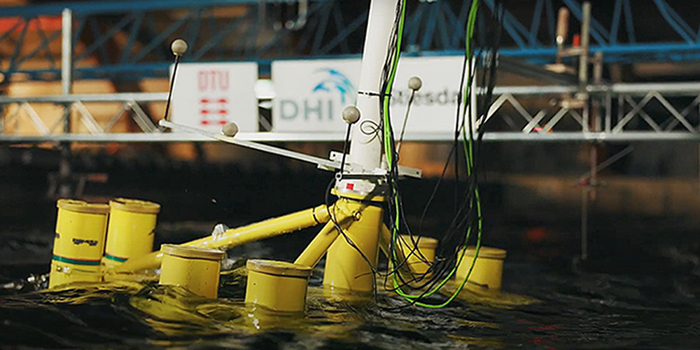Wind turbines that float on the sea will be an important source of sustainable energy in the future. DTU Wind Energy is doing research into floating wind turbines, and students at the department's master's programme in wind energy are currently working with the industry on the development of floating wind energy.
The master's project is carried out in synergy with the research project FloatStep in which DTU Wind Energy in collaboration with industry researches in floating wind energy. In the FloatStep project methods and technologies are evolved to optimize floating wind turbine foundations and tower designs and improve the current technical tools. In addition, the researchers from the project improved the engineering models for the wind turbine loads and calculation methods for the floater which later is going to be validated in full scale against the TetraSpar Demonstrator project of Stiesdal Offshore Technology that is to be installed in Norway during this summer. During this spring tests of a model took place at DHI with a scale model of a floating wind turbine. The two master students, Eric Nicolas Hofschulte and Alex Gandia Santaya conducted the tests as a part of their master project which includes numerical calculations and analysis of the measuring results, too.
Professor and Head of Section at the Department of Wind Energy, Henrik Bredmose, confirms the importance of the topic of the students' project: “The dynamics between the floater and the wind turbine is always an interaction between the load on the rotor, the pressure from the waves and the control – in the conditions at the site. It is important to constantly validate and improve the calculation models in order for them to represent the controlling physics to the extend possible,” he says.
Tests at DHI
Eric Nicolas Hofschulte and Alex Gandia Santaya’s results of the series of tests is going to be applied directly in the FloatStep project. Here, researchers are optimizing the design of the floaters which enables wind turbines to be placed at deep sea. The floating foundation, or floater, is a triangular partially floating structure held in place by strong mooring lines and anchors.
From the students’ results of the tests of the so-called TetraSub model, designed by Stiesdal Offshore Technologies, the wind turbine manufacturer gets new and improved knowledge of the behaviour of the floating foundation of the model and thus gets closer to the full scale floating offshore wind turbine.
The tests were taking place in cooperation with DHI where the students tested a laboratory model of the TetraSub floater in a ratio of 1:60 which was connected to a model of DTU's 10 MW wind turbine. In addition, new control strategies for the TetraSub floating foundation model were tested. Eric Nicolas Hofschulte and Alex Gandia Santaya explain: “The results show that by using the new control strategy, a faster controller, i.e. a control unit, can be applied for floating wind turbines without generating the pitch instability which is usual when using conventional control strategies for floating wind turbines.” The pitch is the gradient of the wind turbine blades when turned slightly lengthwise in order to make the flat side of the blades face the direction of the wind. An adjustment of the pitch is necessary for the wind to push the blades in motion.
The tests were divided into four phases: firstly, the students calibrated the measuring equipment, then they tested the mooring lines for the floater model, subsequently they performed tests of the controller, and finally they tested the software. Eric and Alex explain: "Our main focus of the thesis is on the controller tests, where the DTU Wind Energy Controller's performance was compared with a newly developed modern controller for floating offshore wind turbines." In the tests, the TetraSub floater model was exposed to various influences, including regular and irregular waves. Afterwards, the students analyzed the response of the float to the waves.
Alex and Eric submitted their thesis on 4 June, defended it at the end of this month and received the grade 12. Alex has just signed a job contract with Stiesdal Offshore Technologies and Eric with Wood Thilsted.

Photo: DHI